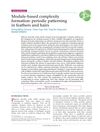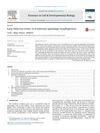TLDR Scientists created feather buds in lab-grown chick skin using specific cell interactions.
The study developed a bioengineering method to reconstruct embryonic dorsal skin from dissociated epithelial and mesenchymal cells of chick skin, allowing for the formation of multiple feather buds in vitro. These bioengineered feather buds, when transplanted onto a chorioallantoic membrane, developed into long feather buds similar in size to native embryos. The number of buds increased with the initial contact length of epithelial and mesenchymal cell layers, highlighting the importance of epithelial-mesenchymal interactions. The formation of these buds was disrupted by inhibiting key signaling pathways such as FGF, Wnt/β-catenin, Notch, and BMP. This technique was expected to advance research on multicellular developmental systems and the regulatory mechanisms of cutaneous appendages.
256 citations
,
October 2013 in “Nature Communications”  165 citations
,
October 2013 in “Nature Communications”
165 citations
,
October 2013 in “Nature Communications” Scientists made working salivary glands in mice using bioengineered cells, which could help treat dry mouth.
 47 citations
,
May 2012 in “Wiley Interdisciplinary Reviews-Developmental Biology”
47 citations
,
May 2012 in “Wiley Interdisciplinary Reviews-Developmental Biology” The conclusion is that understanding how feathers and hairs pattern can help in developing hair regeneration treatments.
 179 citations
,
April 2012 in “Nature Communications”
179 citations
,
April 2012 in “Nature Communications” Regenerated fully functional hair follicles using stem cells, with potential for hair regrowth therapy.
103 citations
,
March 2011 in “PLoS Biology” Birds can lose neck feathers due to a genetic change that increases a gene's activity, helping them adapt to heat.
66 citations
,
June 2004 in “Development” FGF signaling is crucial for starting feather development in chicken embryos.
 160 citations
,
January 2014 in “Seminars in cell & developmental biology”
160 citations
,
January 2014 in “Seminars in cell & developmental biology” Early development of hair, teeth, and glands involves specific signaling pathways and cellular interactions.
4 citations
,
June 2023 in “Journal of developmental biology” The skin systems of jawed vertebrates evolved diverse appendages like hair and scales from a common structure over 420 million years ago.
100 citations
,
November 2017 in “EMBO Reports” Metabolic signals and cell shape influence how cells develop and change.
 36 citations
,
August 2011 in “Journal of Controlled Release”
36 citations
,
August 2011 in “Journal of Controlled Release” Genetically-altered adult stem cells can help in wound healing and are becoming crucial in regenerative medicine and drug design.
August 2025 in “Acta Biomaterialia” The new hydrogel speeds up wound healing by reducing inflammation and promoting tissue growth.






